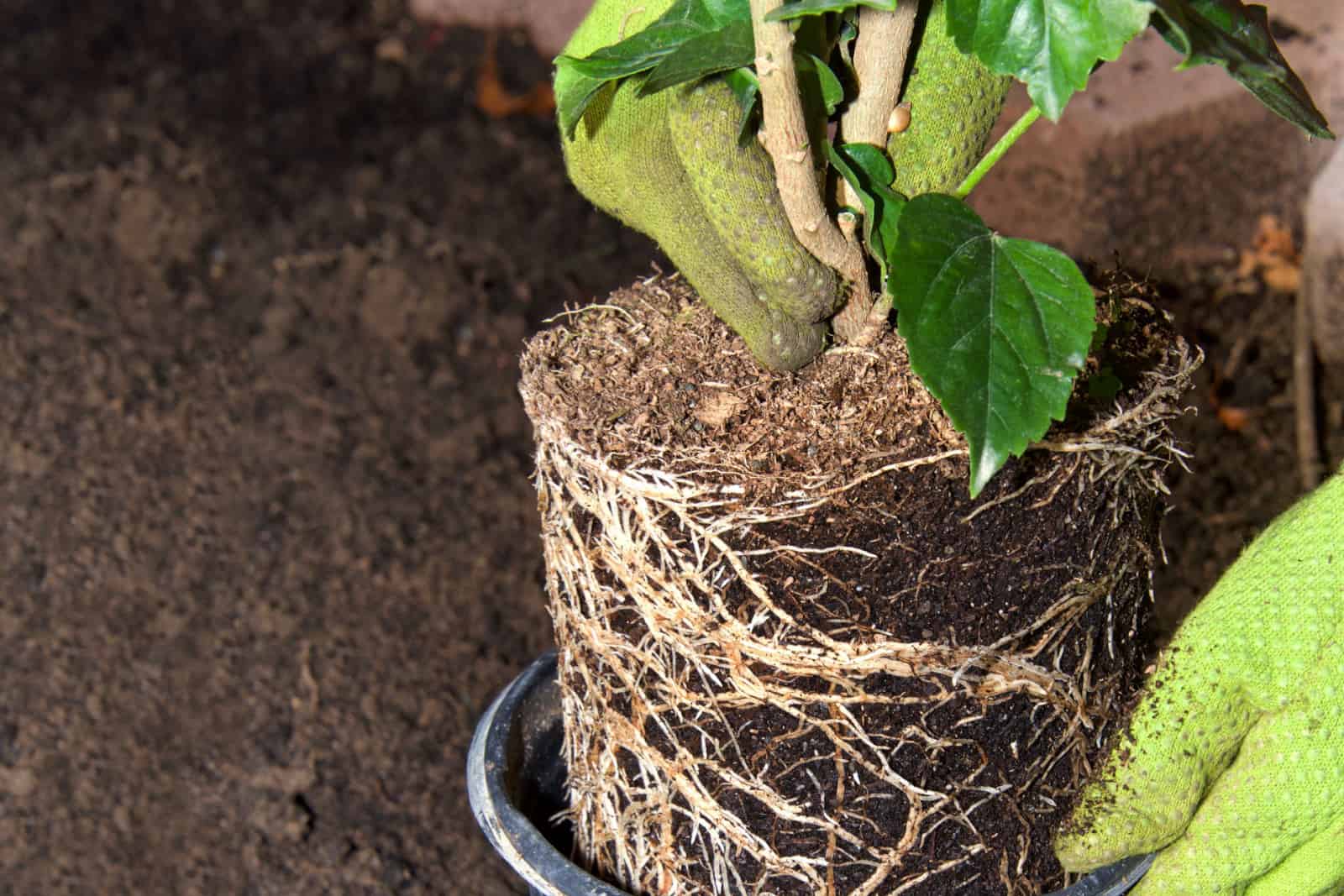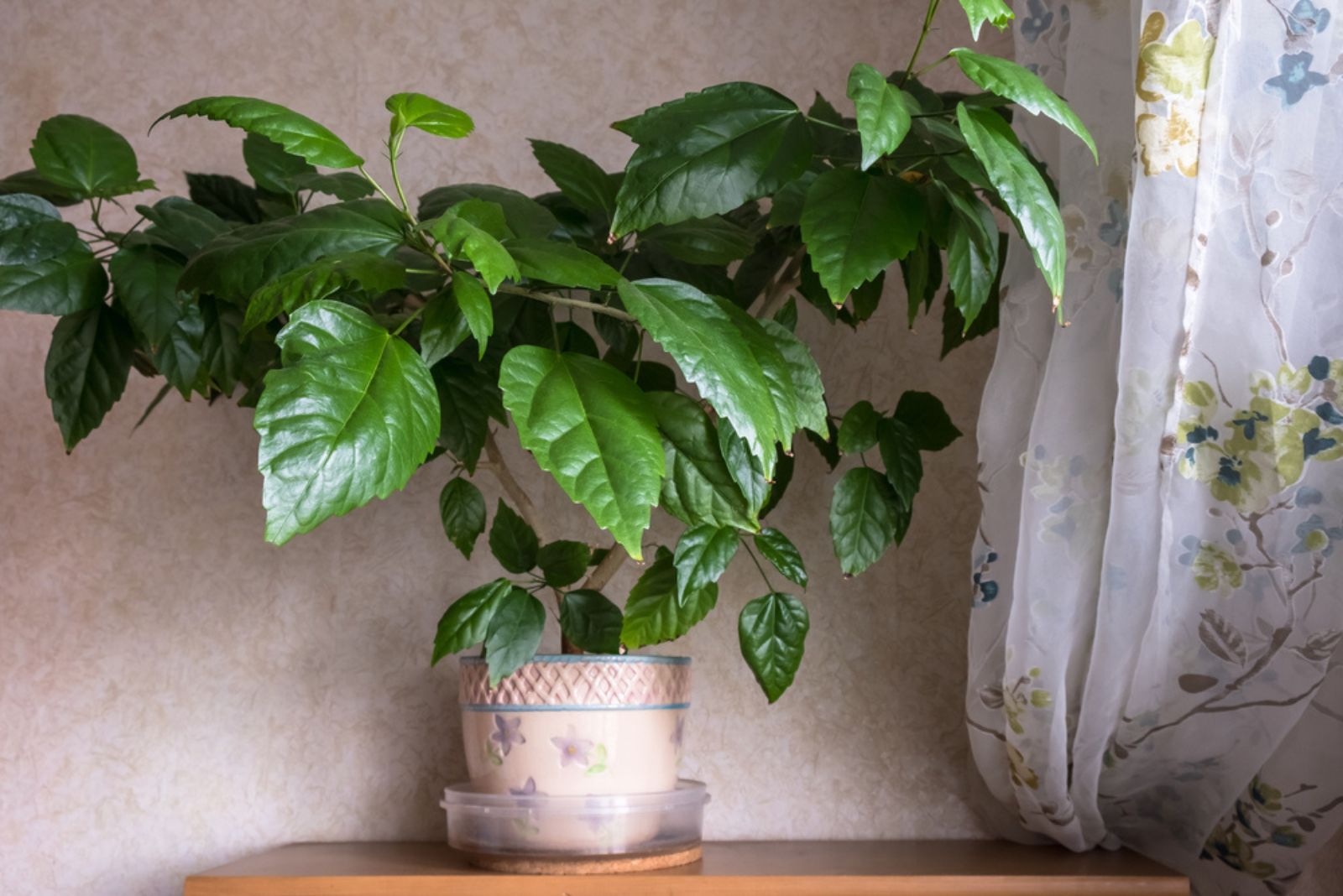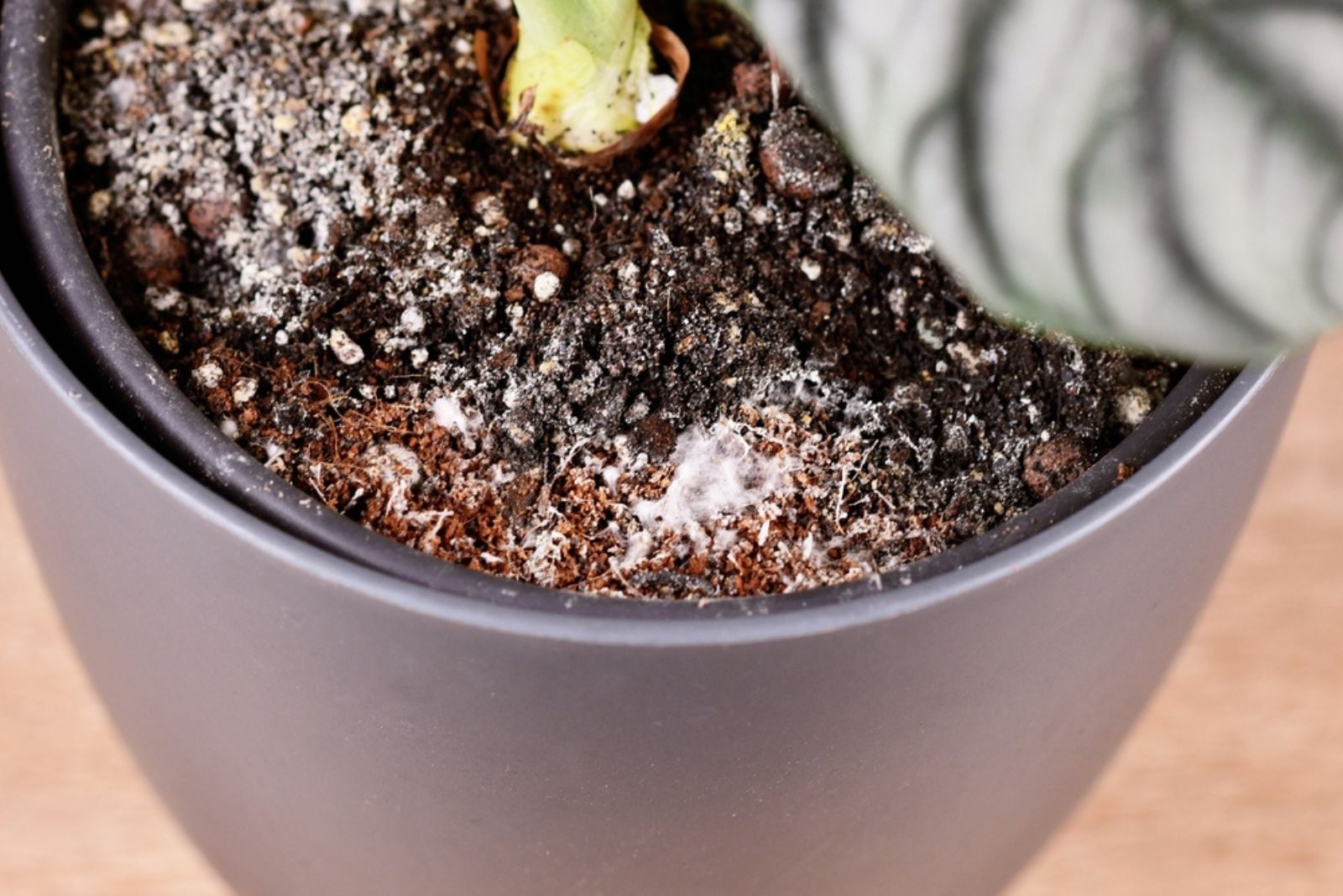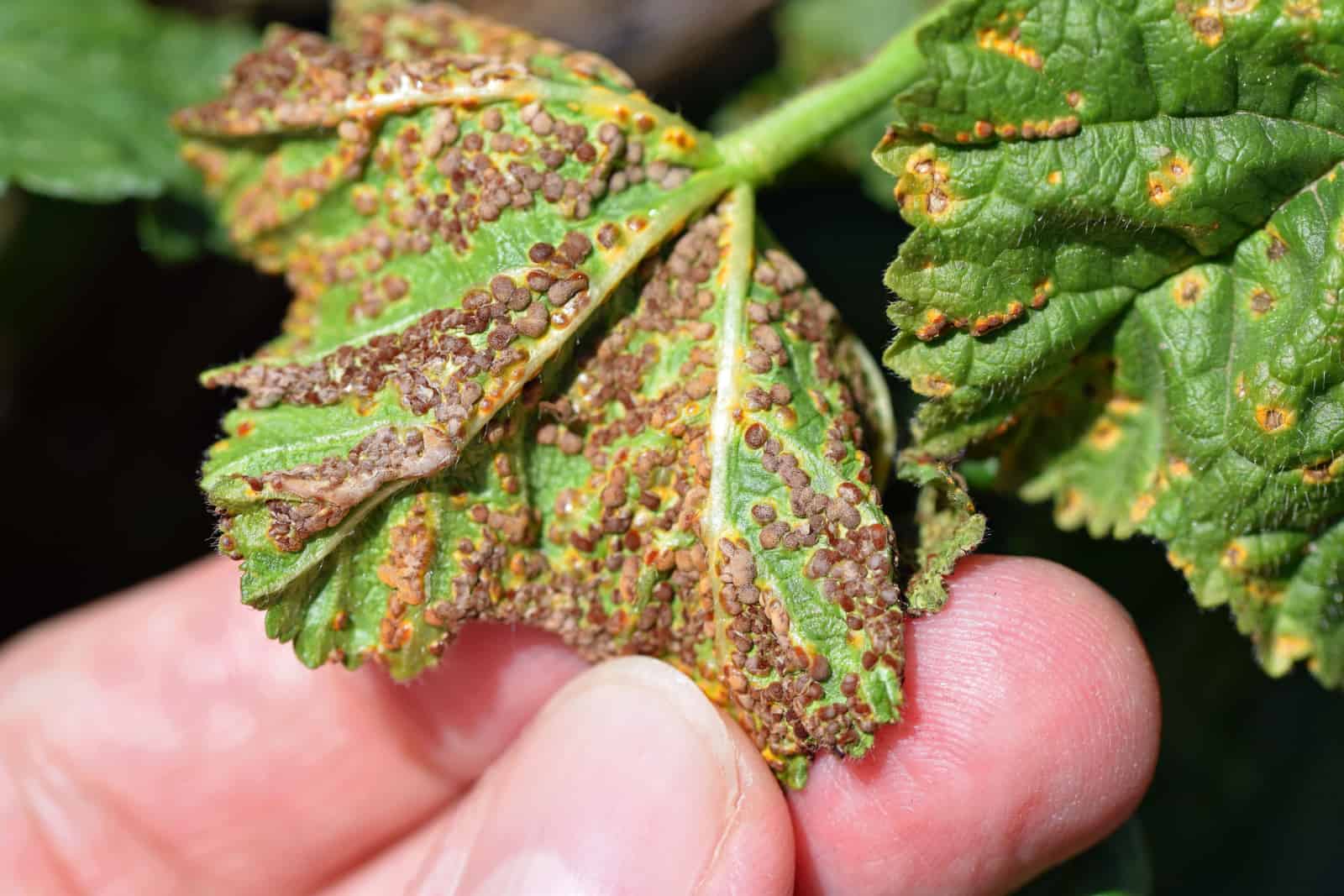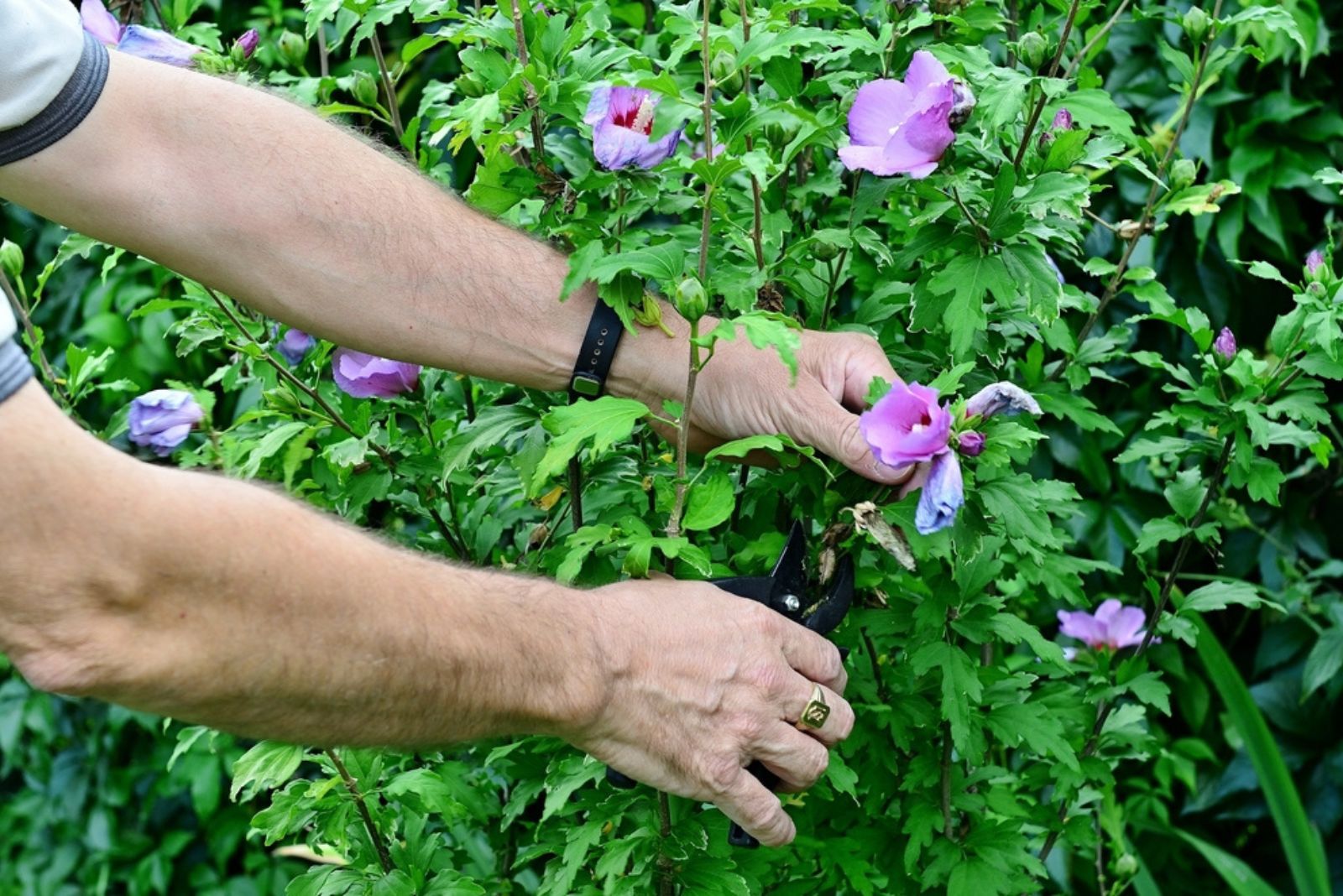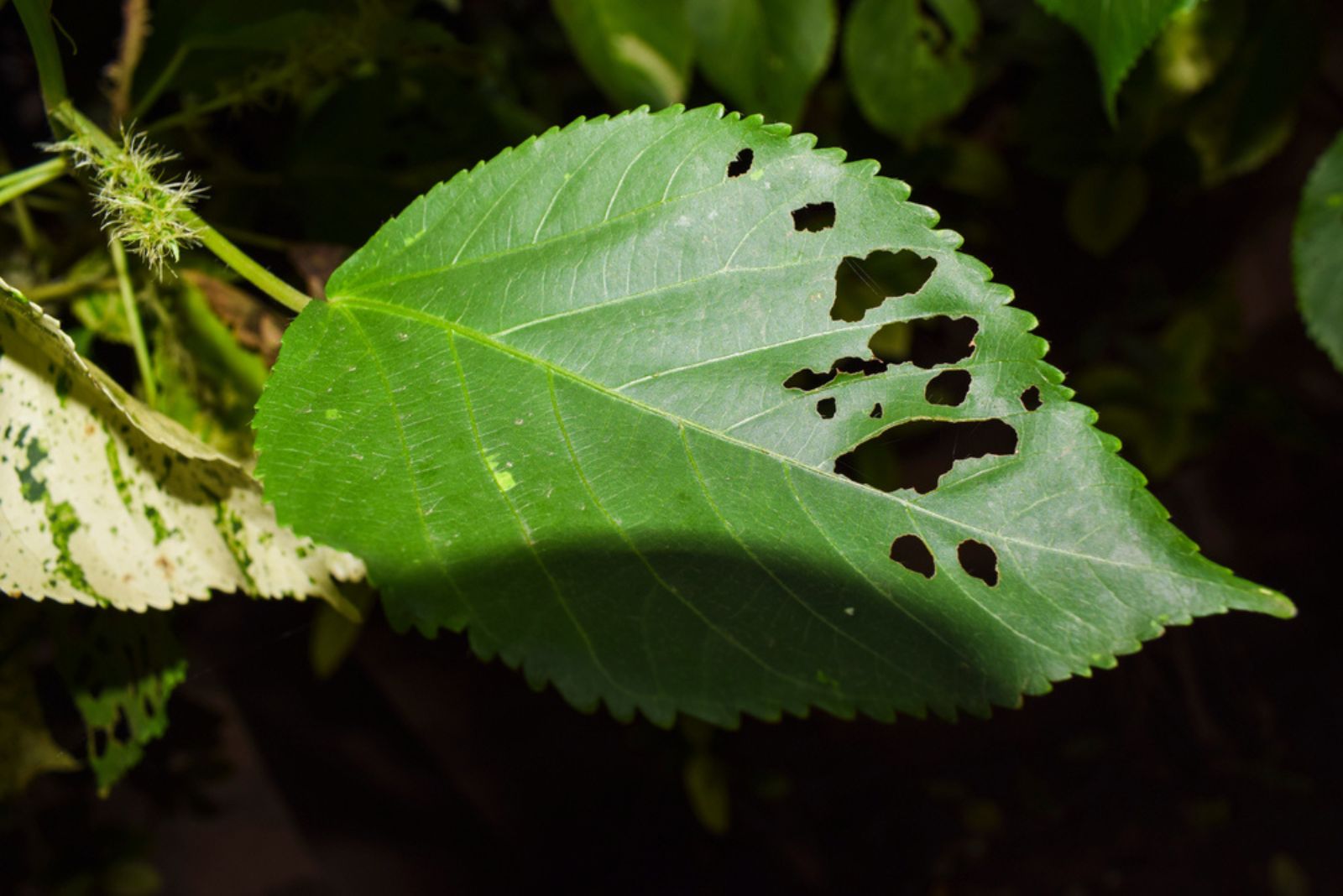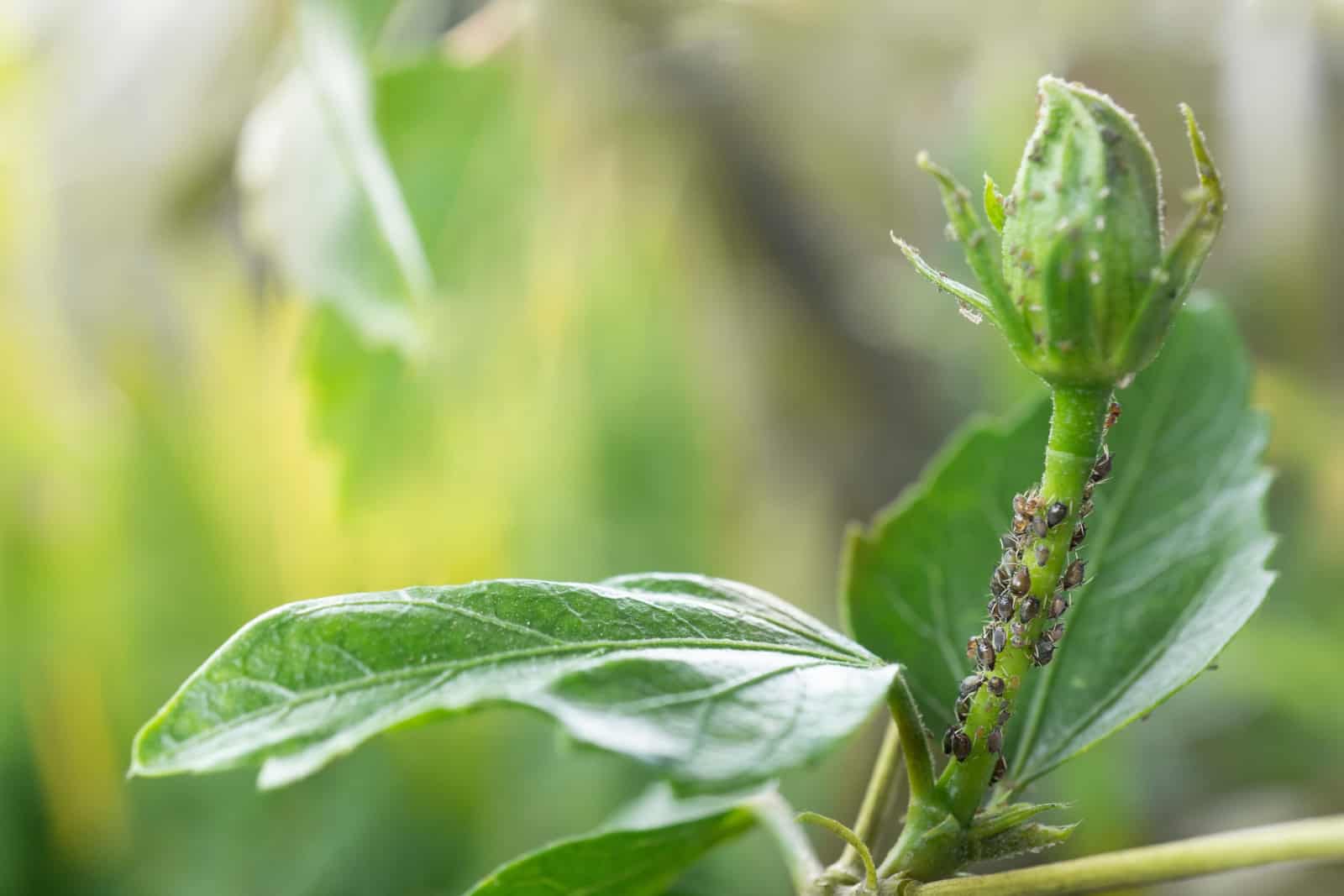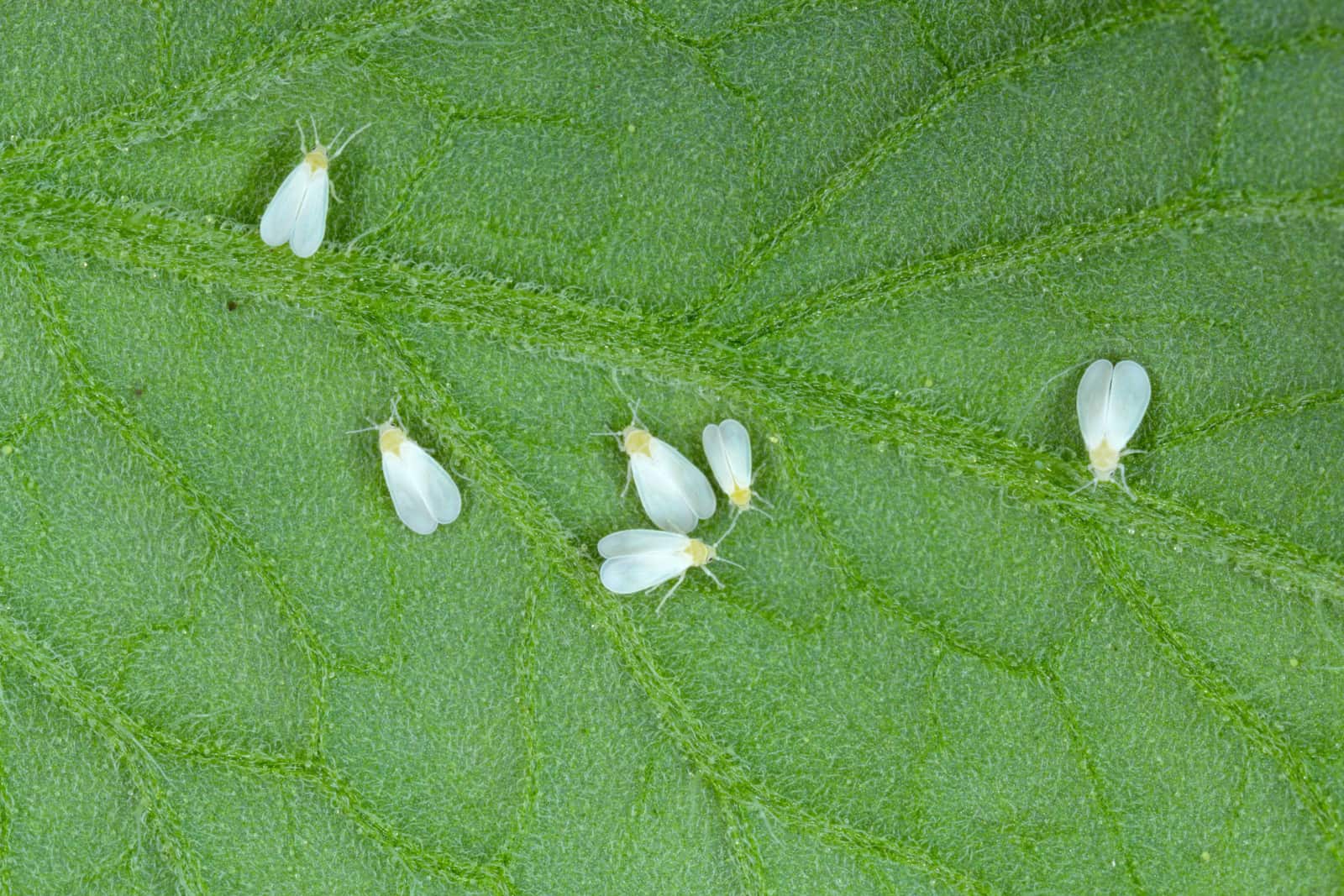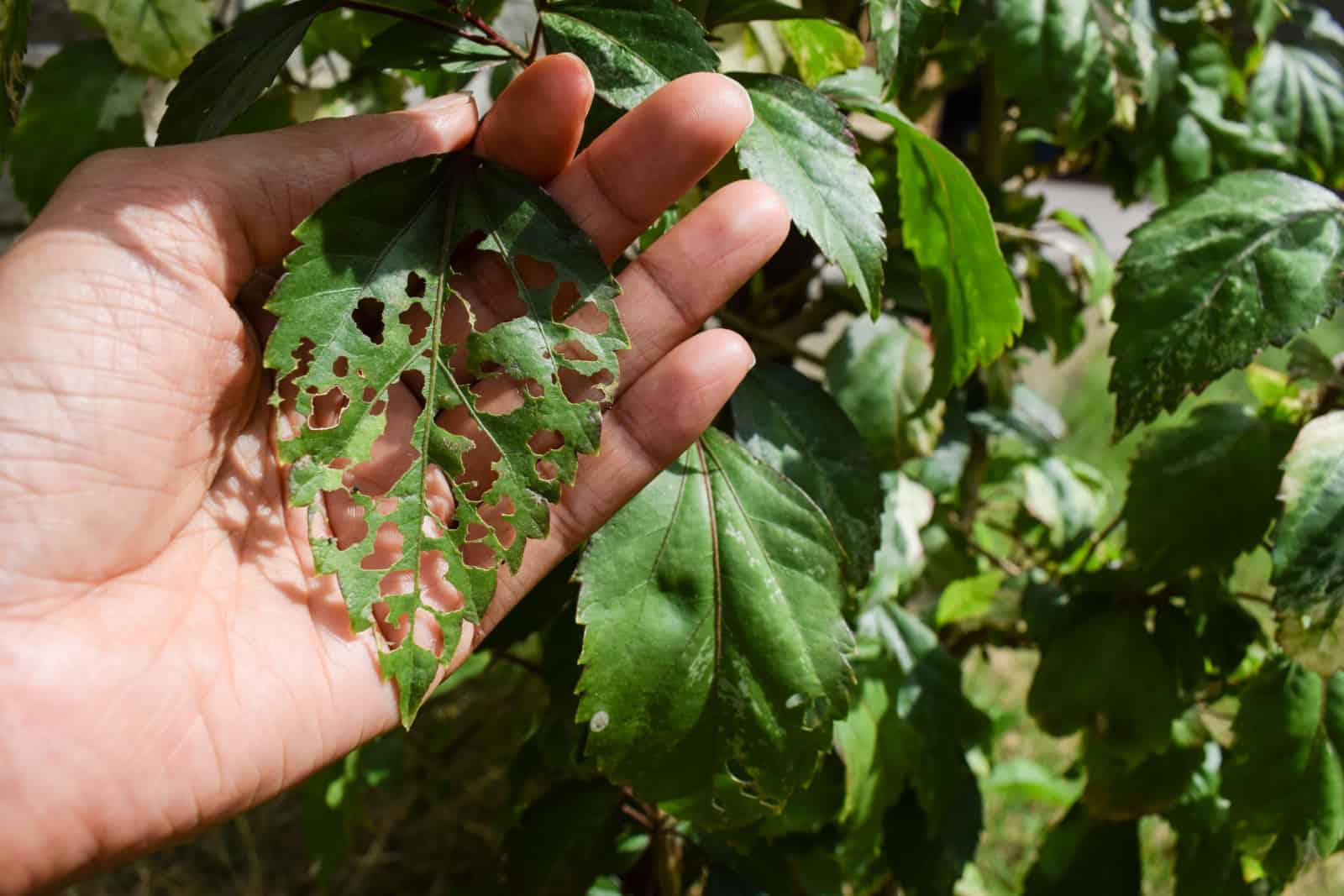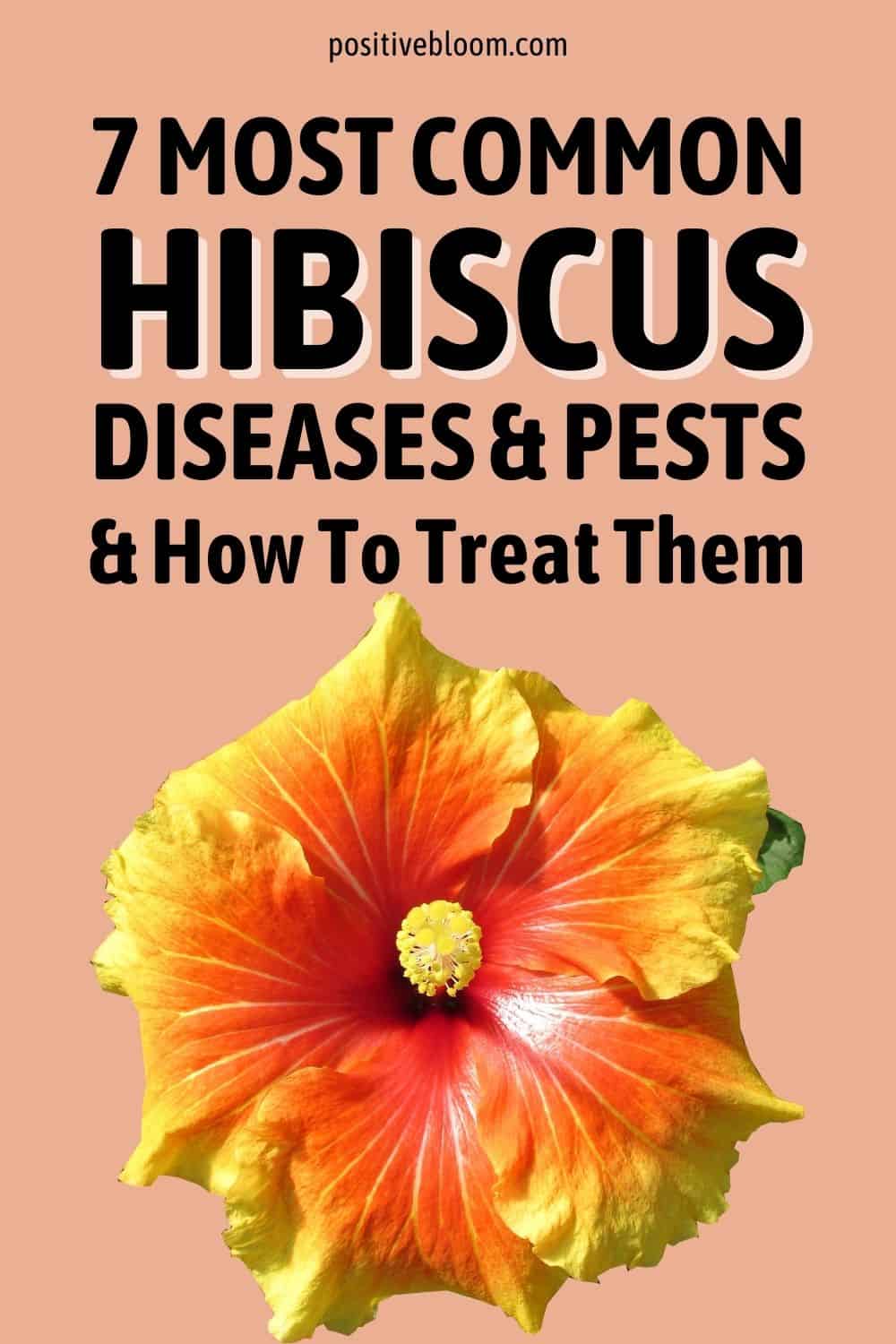There’s nothing better than seeing a healthy and happy plant. Issues aren’t uncommon in plant cultivation, but some can and should worry us.
The Hibiscus is an excellent herb from the Malvaceae family that’s suitable for both in-ground and container gardening.
We can choose from many varieties, such as tropical hibiscus and hardy hibiscus species. We should pay attention to the care requirements of these species as some might not thrive in certain areas.
In this article, I’ll show you 6 hibiscus diseases and pests, how to spot them, and the best ways to treat them. You’ll also find the best prevention methods so your hibiscus can grow healthy and disease- and pest-free.
Let’s get started.
7 Hibiscus Diseases
The 7 most common hibiscus diseases include root rot, leaf spot, powdery mildew, botrytis blight, rust, and wilt disease.
Let’s find out the symptoms of each disease and how to fix it.
1. Root Rot
The most common hibiscus plant disease, and the most common plant disease in general, is root rot. I’m sure you aren’t surprised to see this notorious disease on this list, especially if you grow houseplants.
Root rot is most commonly the result of water accumulation in plant soil. Hibiscus watering needs aren’t high, and that’s an excellent feature for people who often forget to water their plants.
The only problem is that it’s very easy to overwater plants with low watering needs. Once the soil becomes waterlogged, the Phytophthora fungus species begins to appear.
Water clogs all the air pockets in the hibiscus soil and prevents air circulation, so the roots eventually stop breathing. They’ll lose their original color, and their structure will significantly change.
Signs Of Root Rot In Hibiscus Plants
If the hibiscus leaves start turning yellow and dying off, you’ll need to check the root system, as these are common indicators of root rot. Healthy hibiscus roots are typically white and solid.
If the Phytophthora fungus attacks them, they’ll be mushy and turn black or brown.
How To Treat Root Rot
The first thing you need to do is remove your hibiscus from the soil or container.
It’s way easier to take potted hibiscus plants out. Make sure you don’t pull your hibiscus because it’s weak and may cause it further damage.
You can use some garden tools to loosen the soil around the plant and then take it out gently. You’ll need to dry your hibiscus a little, but don’t leave it to dry out completely as this will only create more problems and increase the chances of killing the plant.
Put your hibiscus in a shady spot for about half an hour to dry.
Remember that fungicides won’t work on rotten roots. Sanitize your pruners or shears and cut off the affected hibiscus roots.
Once you’re done with pruning, you can apply fungicide to healthy hibiscus roots. Plant the treated hibiscus in fresh soil, and don’t add too much water or water it too often.
2. Bacterial Leaf Spot
Another disease that frequently affects the hibiscus is bacterial leaf spot. The bacteria Pseudomonas cichorii is responsible for this disease.
Just like the Phytophthora species, Pseudomonas cichorii thrives in a moist environment, so overwatering leads to this issue as well.
Signs Of Bacterial Leaf Spot In Hibiscus
The most common signs of bacterial Leaf spot are lesions on the hibiscus leaves.
The lesions are typically brown and have black margins encircled by a yellowish halo.
How To Treat Bacterial Leaf Spot
The only way to treat this disease is to remove the affected leaves. First, you need to clean your cutting tools with bleach or a similar sanitizing solution.
Cut the diseased leaves, put them in a plastic bag, and seal it tightly. Why is this important? This bacteria can survive on dead leaves, so if you leave them on the ground they’ll keep spreading.
Gardeners often add leaves to their compost piles if they’re healthy.
Dispose of the leaves in case of bacterial leaf spot or any other soil-borne disease.
3. Powdery Mildew
Many hibiscus growers panic when they notice a white powdery substance on their hibiscus flowers. Luckily, powdery mildew disease doesn’t kill hibiscus plants.
Still, the plant looks pretty unattractive in this case, and this fungal disease can affect its health if not treated in time.
Signs Of Powdery Mildew In Hibiscus
The most frequent indicator of this fungal disease is white spots on the leaves. This is the initial phase of the development of infection.
If you don’t treat it, it’ll spread more and more as your hibiscus gets mature.
The spots will turn gray over time, and their size will significantly increase and may end up covering the entire leaf surface.
The most common sign of severe infection is stunted growth.
How To Treat Powdery Mildew
Chemical fungicides will most likely solve the problem, but they should be the last resort!
You can use a few excellent solutions to fix powdery mildew before turning to chemical fungicides.
Before you start using any of the solutions below, stop feeding your hibiscus.
Neem oil is a natural remedy and wins the battle against powdery mildew almost every time.
For best results, dilute 2 tbsp of neem oil in a gallon of water, and pour it into a spray bottle. Apply the solution weekly until the powdery mildew is completely gone.
You can also dilute 1 tsp of baking soda and a couple of drops of vegetable oil in 4 cups of water and spray it over the hibiscus leaves.
4. Botrytis Blight
Botrytis cinerea is the name of the fungus responsible for Botrytis blight aka Gray mold.
The disease mainly affects the hibiscus in its flowering stage; older flowers are in the biggest danger.
Signs Of Botrytis Blight In Hibiscus
Flowers that have been contaminated get brown, papery blotches and are frequently coated in grayish, fuzzy lumps.
Tan to brown patches that resemble targets can also form on the hibiscus foliage.
How To Treat Botrytis Blight
The risk of infection can be reduced by using good sterilizing techniques, which include trimming the plants and cutting off dead or decaying blossoms.
You can dry the affected plant parts, cut off the diseased tissue, and dispose of them in a plastic bag.
Be careful not to water over the hibiscus foliage. Another thing that may contribute to the development of this disease is incorrect spacing; enough space between each plant will aid air circulation.
If using chemical solutions, make sure you use ones with registered substances. For dose recommendations, safety warnings, and indoor use, refer to the label.
5. Rust
Rust is a prevalent disease in species from the Malvaceae (mallows) family. The problem with this hibiscus disease is that it spreads quickly and affects all plant parts fast.
Puccinia malvacearum is responsible for rust disease, and is a soil-borne fungus that can survive harsh winters.
Water can enhance the spread of rust, which makes it even more difficult to treat.
Signs Of Rust In Hibiscus
If your hibiscus suffers from rust disease, it’ll display spots on the leaves that are typically orange or yellow.
Lower leaves will be the first ones to suffer. Brown spots may also occur on the hibiscus stems.
As the infection spreads, the underside of leaves will be covered in reddish-brown bumps aka pustules.
In cases of severe infection, the hibiscus leaves will have holes and most likely die.
How To Treat Rust
It’s very difficult to treat this disease if it progresses. If you notice yellow or orange spots, you can remove the diseased leaves and treat your hibiscus with fungicide.
There are special fungicides on the market for rust disease on ornamental plants that can also be utilized for hollyhock plants.
You can protect new growth by treating the infected parts with fungicide.
If you aren’t into chemical solutions, always work on prevention; dispose of them in the case of severely affected plants.
6. Wilt Disease
There are species of fungus, Fusarium, and Verticillium that frequently cause wilt disease in many plant varieties.
Many refer to this fungal disease as root rot, but they are two separate diseases.
Yellow leaves typically occur as a result of root rot. Still, if the leaves of your hibiscus shrivel and aren’t yellow, you are dealing with wilt disease.
Signs Of Wilt Disease In Hibiscus
When a hibiscus plant has wilt disease, the foliage typically retains its original green color or gradually turns a deep green, brown, or almost black hue as it wilts.
In the case of wilt disease, the entire plant or half of it will have wilting leaves. One wilted leaf doesn’t indicate wilt disease!
How To Treat Wilt Disease
You may not be able to save a hibiscus plant grown in-ground if it’s severely affected by wilt disease.
There isn’t any chemical product on the market that can be used to treat this disease. You should dispose of the diseased plants and allow the soil to rest for approximately 5 years.
In the case of wilt disease in a potted hibiscus, try moving the plant out of direct sunlight and misting it regularly. Never prune, repot, and fertilize diseased plants if you want to avoid further damage.
7. Dieback Disease
When we prune our hibiscus plants, we may accidentally create wounds that are perfect entry points for fungus or bacteria.
Signs Of Dieback Disease In Hibiscus
The entire plant or one side of a hibiscus plant may wilt if the plant suffers from wilt disease.
However, if only one branch wilts and your plant seems ‘healthy’, you may be dealing with dieback disease.
How To Treat Dieback Disease
The best treatment for this disease is to remove the wilted branch. You may not see the wound immediately, so you’ll need to keep cutting until you spot it.
When you locate it, trim it by making a clear incision below the nodes.
Insect Pests On Hibiscus Plants
A severe pest infestation can kill your hibiscus plant very fast, so treating pests in the early stages is crucial.
Aphids, spider mites, whiteflies, thrips, mealybugs, and scale are all pests you can find on hibiscus plants.
Your hibiscus will display changes in appearance depending on the type of pest it deals with. Yellow leaves, wilting, browning, red or black spots, and webbing are all signs of pests.
Let’s see the signs and treatment of specific pests on the hibiscus plant.
Aphids
These are tiny insects that enjoy feeding on hibiscus juices, and they prefer stems and flower buds.
They are known to reside in colonies and may come in various colors, such as red, white, black, or green.
So, how can you tell if your hibiscus has aphid insect problems? Inspect your hibiscus and look for ants; they love the honeydew that aphids excrete. Sooty mold may also develop as a result of honeydew.
Aphid populations have the potential to explode and inflict serious damage if left untreated.
Other signs of an aphid infestation include curling, yellowing, and deformed foliage.
How To Treat An Aphid Infestation
One of the best ways to control pests during flowering is by using insecticidal soap. You can find many excellent types of insecticidal soap on the market, but pay attention to dosage and application.
Before you start using any products, you can significantly decrease the number of aphids by washing the plant’s leaves using a garden hose.
Purchasing beneficial insects such as lacewings and ladybugs is another excellent strategy for dealing with these naughty pests.
Spider Mites
These are probably the hardest creatures to spot when it comes to pests. The most frequent sign of naughty mites on these flowering plants is webbing. Believe it or not, you’ll need to use a magnifying glass to make sure spider mites are the culprit.
These pests remove the fluids from the leaves, giving them a mottled look. The leaves wither and die in the case of severe infestations, but the plant typically survives (if treated accordingly).
The biggest problem is that you can find spider mite eggs in plant soil, so treating the entire plant is essential.
Mature spider mites can’t live without plants, so they most likely won’t come back once you remove them.
How To Treat A Spider Mite Infestation
Many growers use neem oil for treating a spider mite infestation. It doesn’t contain chemical compounds that can destroy the plant or its roots.
You can also use insecticidal soap, rubbing alcohol, or go with an insecticide.
Whiteflies
There are three types of whiteflies that frequently attack hibiscus plants:
1. Greenhouse whitefly (glasshouse whitefly)
2. Sweet potato whitefly
3. Silverleaf whitefly
As their name suggests, these are white insects, and the easiest way to spot them is by shaking your hibiscus a little bit.
If your plant is infested, many whiteflies will come out after shaking.
In the case of severe infestation, you’ll be left with yellow, shriveled, and fallen leaves.
How To Treat A Whiteflies Infestation
When I was younger, I thought sticky, yellow fly traps were the ugliest thing ever made. That was until they saved me from a severe whitefly infestation!
You can eliminate whiteflies from your hibiscus by placing fly traps near the plant or on the soil.
You can also pour some vinegar into a shallow dish and add a few drops of dish soap to get rid of whiteflies.
Another excellent technique is putting an overripe fruit in a shallow dish, wrapping it with a plastic bag, and poking a few holes in it. Whiteflies can’t resist!
Thrips
One of the surest signs your hibiscus has thrips is bud drop. There’s a simple reason for this; mature thrips lay their eggs on the hibiscus flower buds and then larvae eat the bud.
If your hibiscus is attacked by these pests, you’ll also notice scratches all over your plant.
How To Treat A Thrips Infestation
Insecticidal soap and neem oil are two effective natural remedies for thrips. Pay attention and apply the solutions all over your hibiscus.
Thrips are also great at hiding, so make sure to spray the undersides of the leaves too.
If these insects are giving you a very hard time and nothing seems to work, you should consider using pest control products such as Spinosad.
This product has been labeled as safe for plants, but pay attention to dosage and application.
Mealybugs
If you are growing the Hibiscus rosa-sinensis plant or its cultivar the Peach hibiscus, you may often encounter mealybugs.
These white insects consume the juices of hibiscus plants, which can limit development and prevent blossoms from opening. They generate honeydew, which may support the growth of sooty mold.
How To Treat A Mealybugs Infestation
One of the easiest ways to treat mealybugs on a hibiscus is by dipping a soft sponge in rubbing alcohol and rubbing the leaves.
You can also use solutions such as insecticidal soap or horticultural oils to eliminate these annoying pests.
Scale
When there is a serious scale invasion, these creatures can be seen with the naked eye.
They’ll steal nutrients from your hibiscus, suck out the sap, and lay their eggs.
Like many other insects, scales also excrete honeydew and enhance fungus growth, which results in blackish mold.
How To Treat A Scale Infestation
The first thing you need to do is isolate your hibiscus; of course, this only works for potted plants.
The next step is scraping; try to scrape off as many scales as possible.
If the infestation is severe, you should cut off the highly affected leaves.
Neem oil, isopropyl alcohol, and insecticidal soap are excellent ways to treat scale insects.
If none of this works, you might want to treat your hibiscus with pesticides.
How To Prevent Hibiscus Plant Diseases And Pest Infestation
Hibiscus plants attract hummingbirds and smell amazing! Hibiscus tea has many health benefits, and they make an attractive addition to an indoor or outdoor setting.
If you take good care of your hibiscus, you don’t need to worry about pests and diseases much.
But what are the perfect conditions for these plants?
Here are a few care tips for your hibiscus that’ll keep it safe from both pests and diseases.
1. Light: These plants require lots of sun but may benefit from partial shade, especially in areas with warm weather. If you grow a hibiscus indoors, a spot near a sunny window will give the best results.
2. Humidity: All hibiscus species, including the Rose of Sharon and cranberry hibiscus, thrive in high humidity. If you live in an extremely arid region, I recommend growing your hibiscus indoors as it’s way easier to control and maintain the correct humidity level.
3. Watering: All species from the Hibiscus genus thrive in moist soil, so you’ll need to water them frequently, especially when it comes to potted plants. If growing these plants in-ground, don’t water them too often, and add water only if it doesn’t rain for a while.
4. Temperature: A range of 60-85°F will meet the needs of a tropical hibiscus, whereas a hardy hibiscus species can withstand temperatures as low as -20 degrees Fahrenheit.
5. Soil: Well-drained soil with good air circulation will enhance the growth of this flowering plant and prevent many issues. You can enhance airflow by supplementing the soil with perlite or similar ingredients.
6. Feeding: This is a flowering plant, which means plant food with high concentrations of minerals, such as nitrogen and potassium, will work best. For outdoor plants, use slow-release fertilizer types, and for indoor plants, liquid fertilizer will work better.
7. Pruning: Your hibiscus typically displays new growth in spring, so I recommend cutting it back in late winter or at the beginning of the spring. Deadheading of spent flowers will also encourage new growth, as well as removing all damaged or discolored leaves.
8. Repotting/transplanting: You’ll be able to avoid transplant shock by gradually taking your hibiscus seedlings outdoors to adapt. If growing hibiscus in containers, refreshen the soil and get a larger container once the plant becomes root bound.
Wrapping Up
Growing hibiscus plants is an amazing experience. I mean, the plant has so many benefits and it’s pretty easy to maintain, and once you spot the flowers, I’m sure you’ll be happier than ever.
Plants, like all living creatures, aren’t really problem free. But you know how it goes; the sooner you start treating the issue, the sooner it’ll recover!
I showed you the 7 most common hibiscus diseases and pests, their signs, and the best ways to treat them.
Follow our advice, and I’m sure you’ll solve the problem quickly.
Good luck, and until next time!
Like this post? Share or pin it for later!

